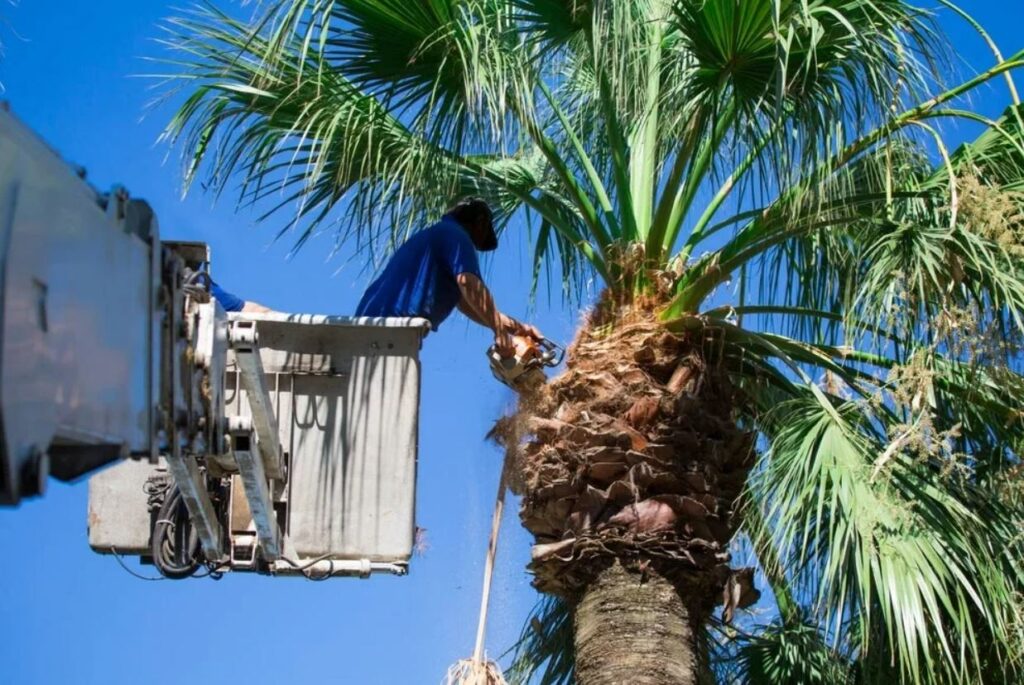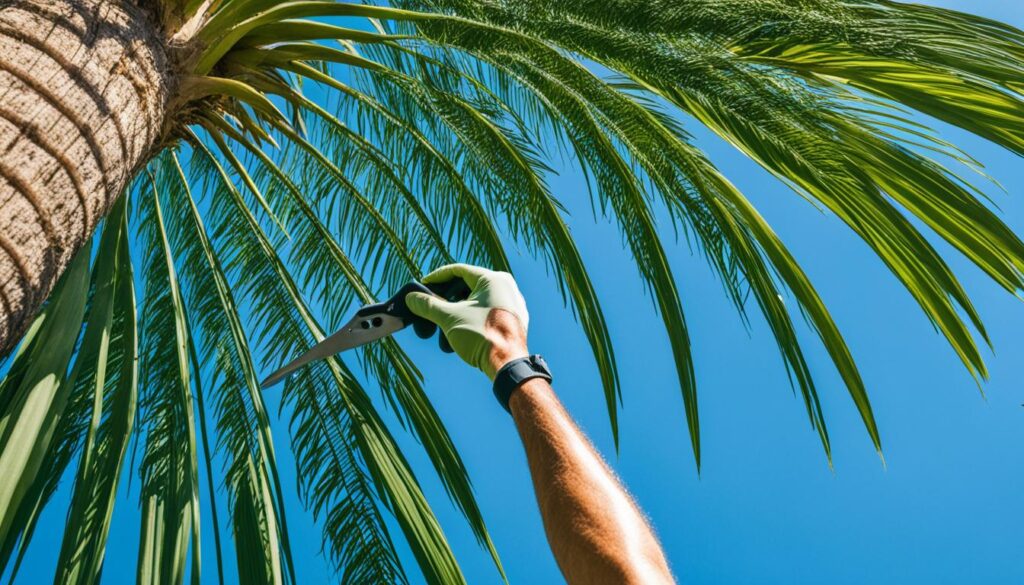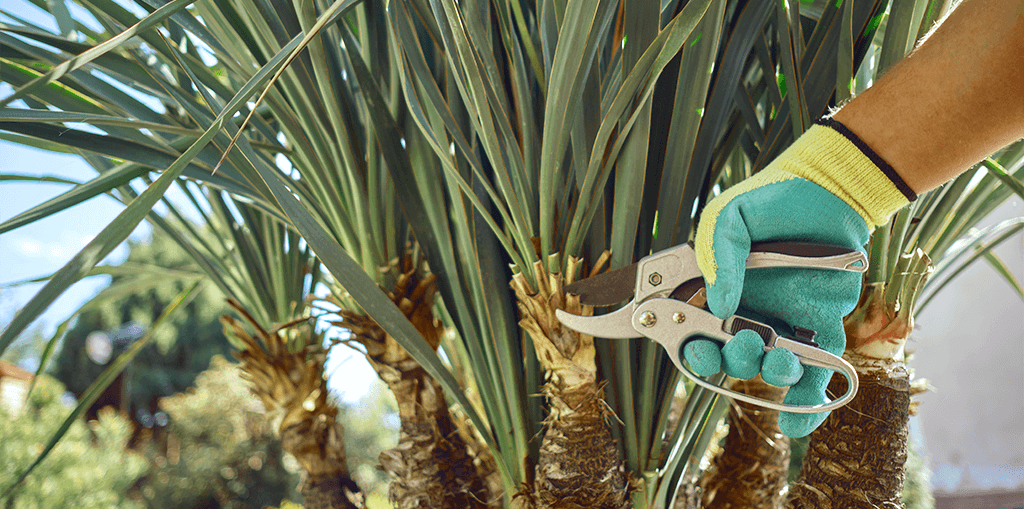Palm trees are a beautiful addition to any tropical landscape, adding a touch of elegance and relaxation to your surroundings. To keep your palm trees looking their best, regular pruning is essential. Pruning not only improves the aesthetic appeal of your trees but also helps to maintain their health and vitality. In this article, we will explore the basics of palm tree pruning, the tools needed for the job, a step-by-step guide to pruning, common mistakes to avoid, and post-pruning care.
Understanding the Basics of Palm Tree Pruning
Palm tree pruning involves the removal of dead or dying fronds, seed pods, and flowers. By eliminating these parts, you help to keep your trees healthy and prevent potential hazards. Proper pruning also encourages new growth and allows more sunlight to reach the tree’s interior, promoting overall vigor.
When pruning your palm trees, it’s essential to use sharp and clean tools to make precise cuts. Avoid cutting too close to the trunk as this can damage the tree and leave it vulnerable to infections. Additionally, remember to remove any coconuts before pruning to prevent accidents and ensure your safety.
Importance of Pruning for Palm Trees
Pruning is crucial for palm trees as it helps to prevent the accumulation of dead fronds, which can become a fire hazard during dry seasons. Furthermore, removing dead fronds also reduces the risk of pests and diseases, keeping your trees in optimal condition.
Regular pruning also enhances the aesthetic appeal of palm trees, giving them a neat and well-maintained appearance. Trimming away old fronds can reveal the tree’s natural beauty and create a more inviting landscape in your garden or property.
When to Prune Your Palm Trees
The best time to prune palm trees is during the warmer months of spring and summer. Pruning during this time allows the tree to heal more quickly and promotes faster regrowth. However, if you live in an area with cold winters, it’s advisable to wait until the last frost has passed before pruning.
Before starting the pruning process, take the time to inspect the tree for any signs of pests or diseases. Addressing these issues before pruning can help prevent their spread and ensure the long-term health of your palm trees. Additionally, consider consulting a professional arborist for larger palm trees or if you are unsure about the proper pruning techniques for your specific palm species. Learn more about tree pruning pricing.
Tools Needed for Palm Tree Pruning
Before you get started with pruning your palm trees, it’s important to gather the necessary tools. These tools will help make the process safer and more efficient.
Pruning palm trees is a delicate task that requires precision and the right equipment. By using the correct tools, you can ensure the health and aesthetics of your palm trees for years to come.
Safety Equipment for Pruning
First and foremost, ensure that you have the appropriate safety equipment. This includes gloves to protect your hands from sharp fronds, safety goggles to shield your eyes from debris, and sturdy footwear to provide stability while working at heights.
Wearing long sleeves and pants can also protect your skin from scratches and irritations caused by the rough texture of palm tree bark and fronds. It’s essential to prioritize safety to prevent any accidents or injuries during the pruning process.
Choosing the Right Pruning Tools
Investing in high-quality pruning tools will make your job much easier. A few essential tools include bypass pruning shears for small fronds, loppers for thicker branches, and a pruning saw for larger fronds or seed pods. Additionally, a ladder or pole pruner may be necessary for reaching higher parts of the tree.
Before using any pruning tool, make sure they are sharp and clean to create clean cuts that promote faster healing for the palm tree. Dull or dirty tools can cause damage to the tree and increase the risk of infections. Proper maintenance of your pruning tools is key to successful palm tree pruning.

Step-by-Step Guide to Pruning Palm Trees
Now that you have the necessary tools, it’s time to get started with pruning your palm trees. Follow this step-by-step guide for the best results.
Pruning palm trees is not only essential for their aesthetic appeal but also for their overall health and well-being. By removing dead or brown fronds, you are allowing the tree to allocate more energy to new growth, promoting its vitality and longevity.
Identifying Which Fronds to Prune
Begin by assessing your palm tree and identifying which fronds need to be pruned. Look for dead or brown fronds, as well as any crossing or rubbing branches. These are the ones that should be removed to improve the tree’s appearance and health.
Additionally, consider the location of the fronds you are pruning. Fronds that are close to the ground or obstructing walkways should also be prioritized for removal to enhance both the tree’s beauty and accessibility around your property.
Proper Techniques for Cutting Palm Fronds
When it comes to cutting palm fronds, it’s essential to use proper techniques. Start by cutting the frond at the base, close to the tree trunk. Avoid leaving stubs, as they can provide entry points for pests and diseases. If a frond is too large to handle, use a pruning saw to make an undercut first before making a top cut.
Remember to sterilize your pruning tools before and after each use to prevent the spread of diseases between trees. By maintaining clean tools, you are ensuring the health of your palm trees and promoting a professional approach to tree care.
Common Mistakes in Palm Tree Pruning
Although palm tree pruning is relatively straightforward, there are a few common mistakes that you should avoid to ensure the health and longevity of your trees.
Proper palm tree pruning not only enhances the aesthetic appeal of your landscape but also plays a crucial role in the overall health of the tree. When done incorrectly, pruning can have detrimental effects on the tree’s growth and vitality.
Over-pruning and Its Consequences
Over-pruning, or removing too many healthy fronds, can weaken the tree and make it more susceptible to disease and stress. It’s important to strike a balance between removing dead fronds and maintaining enough healthy foliage for photosynthesis and nutrient absorption.
Each frond on a palm tree serves a specific purpose, from providing nutrients to supporting the tree’s structure. Removing too many fronds disrupts this delicate balance and can hinder the tree’s ability to thrive.

Incorrect Timing of Pruning
Pruning at the wrong time of year can also have adverse effects on your palm trees. Avoid pruning during the colder months or immediately before extreme weather conditions, as this can cause unnecessary stress on the tree.
It’s essential to consider the natural growth cycle of palm trees when scheduling pruning sessions. Performing major pruning tasks during the tree’s active growing season can disrupt its natural rhythm and leave it vulnerable to environmental stressors.
Post-Pruning Care for Your Palm Trees
Once you have completed the pruning process, it’s crucial to provide your palm trees with the necessary care to promote healing and regrowth.
Watering and Fertilizing After Pruning
After pruning, give your palm trees a thorough watering to help them recover from the stress of the pruning process. Adequate hydration is essential for the palms to bounce back and start regrowing. Remember that palms are sensitive to overwatering, so it’s important to find the right balance. In addition to watering, applying a slow-release palm fertilizer can provide the necessary nutrients for healthy growth. The fertilizer should be rich in micronutrients like manganese, magnesium, and iron, which are crucial for vibrant green fronds.
Monitoring for Signs of Disease or Stress
Keep a close eye on your palm trees in the weeks following pruning. Look out for any signs of disease, such as discoloration or wilting fronds, and take appropriate action if necessary. Palms are susceptible to various diseases like fungal infections and nutrient deficiencies, so early detection is key to addressing these issues effectively. Regularly inspecting your trees will help to catch and address any problems early on, ensuring the long-term health of your palms.
Furthermore, consider applying a thin layer of organic mulch around the base of your palm trees after pruning. Mulch helps retain soil moisture, regulates soil temperature, and reduces weed growth. It also slowly breaks down, providing essential nutrients to the palm’s root system. When applying mulch, ensure it doesn’t touch the trunk of the palm to prevent rot and fungal issues.
In conclusion, palm tree pruning is an essential part of maintaining the health and appearance of your tropical trees. By understanding the basics of pruning, using the right tools, following proper techniques, and avoiding common mistakes, you can ensure that your palm trees thrive. With post-pruning care, including proper watering, fertilizing, monitoring for diseases, and mulching, your palm trees will continue to bring beauty and tranquility to your outdoor space for years to come.
